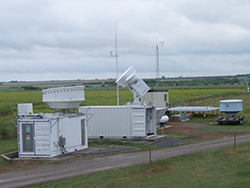Midlatitude Continental Convective Clouds Experiment (MC3E)
In the spring of 2011, ESRL's Physical Sciences Laboratory (PSL) participated in the MC3E field experiment,
which aimed to sample the complete lifecycle of convective clouds including the build-up, the mature, and the decaying
phases. Observations from the experiment will help parameterize precipitation processes in
weather models and help improve rainfall estimates using satellite observations.
PSL deployed a 449-MHz wind profiler and a 2.8-GHz precipitation profiler at the DOE Southern Great Plains (SGP)
field site near Ponca City, Oklahoma. Both radars are pointed vertically to sample the vertical structure of precipitation
that passes overhead. The 449-MHz profiler provided observations of the vertical air motion, and the 2.8-GHz profiler
observed the hydrometeor motion – raindrops, hail, and ice particles being lifted and pushed downward
by the vertical air motion. By combining these two observations the number and size of raindrops can be estimated
in the vertical column which provides information on the microphysical processes occurring in the cloud systems.
In addition to PSL's two profilers, four more frequency radars and nine scanning poarimetric radars were used.
Aircraft were also flown over the site, and balloons were launched from 5 locations around the site every 3 hours
during rain events.
Sponsors
|

A field site for MC3E
|
|
|
|